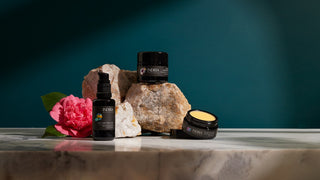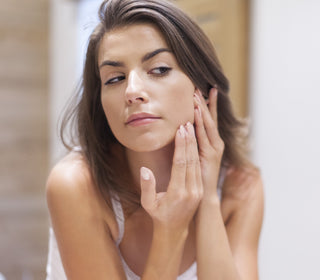I’m going to make an assumption - even though I’ve come to understand that assuming makes an ass out of you and me - that if you’re here reading this blog, you love skincare, but probably more than that, you’re seeking to achieve your most perfect skin. If I’ve nailed it in one, read on, as I’m taking the time today to discuss what happens when, in an effort to achieve perfect skin, one goes too far and compromises their skin barrier instead.
Skin barrier, I hear you say, what’s that?! Well, I guess if you’re as obsessed with skincare as I am, you probably know exactly what the skin barrier is, but if not, let me enlighten you.
The epidermis is the uppermost layer of the skin that sits above the dermis, with its main function to create a barrier between the lower levels of the skin and the environment. Barrier function is the skin’s ability to block irritants and microbes from entering the skin, whilst also preventing the loss of substances from the skin such as water.
For those interested in a little more nerdy detail, the epidermis is less than 0.1mm thick and even though that’s obviously very thin, it’s role is extremely important and when intact, it’s super effective at what it does. The stratum corneum is the outer most layer of the epidermis and is approximately 15-20 skin cells deep (and yes, dead skin cells by the way). It is perhaps the ultimate hero of the entire skin structure, keeping out the baddies, keeping in the goodies and stopping water from evaporating – all whilst preventing oxidative damage.
The effectiveness of the stratum corneum relies on a complex matrix of proteins and water binding humectants which allow for its bricks and mortar-like structure to waterproof and provide flexibility. Old cells in the stratum corneum are constantly being shed (around one layer per day) and it replaces itself entirely roughly every two weeks.
Now that you're full bottle on the importance and function of the epidermis, the next important thing to consider is what happens when the skin barrier is compromised. And by compromised, I mean that it’s either been thinned or weakened, usually from over-enthusiastic exfoliation from cosmetic acids that are so on-trend and easily available right now.
Don’t get me wrong, used following well-considered advice from your trained therapist or dermatologist, there is very much a place for AHAs and BHAs in skincare, however many people use these products without education and far more regularly than they should, leaving their skin in a state of disarray because of it.
Often, tell-tale signs of a compromised skin barrier include redness when using skincare products with any level of active ingredient (essential oils also technically falling into this category), dehydration, acne and dullness.
Dehydration occurs because the thin skin barrier can’t adequately prevent water from evaporating from the lower layers of the skin. In turn, dehydration can also lead to signs of acne caused by inflammation, dead skin cell build-up, and a general imbalance within the skin.
Red skin on the other hand usually occurs because the skin’s ability to act as a barrier is weakened, so irritants and allergens can reach the living layers of your skin (the dermis) more easily and cause burning and often stinging.
And dullness often occurs because the skin’s natural lipids have been stripped during the over-exfoliation process, or as a result of the over-application of actives or retinols.
Now that I’ve delivered the bad news, it’s time to give you some more positive news don’t you think? Here it is: if you do suffer from compromised skin, hope is real!
Much like dumping that partner that doesn’t treat you with the love and respect you deserve and switching to a partner that treats you like the queen (or king) that you are, flicking a routine that impairs your skin barrier and introducing a routine that is gentle and effective, can deliver almost immediate results.
You may remember that I mentioned above that your stratum corneum replaces itself approximately every two weeks which is your first hint that within this time real change can occur. In fact once the stratum corneum is returned to full health, you will notice a huge difference in the appearance, balance and overall comfort of your skin. And better still, it means that your skin will be then able to readily accept the wonderful array of actives on the market that can really bring about skin change.
It's important to note that depending upon the damage to your skin barrier, returning it to full health can be a much longer process and may require oversight from a dermatologist, so please consider whether this applies to you.
How to improve your skin barrier
Now this is the million-dollar question, right?!
And dare I say it, the answer may actually be way easier than you may think.
Like the famous Bob Newhart ‘Stop it’ skit https://www.youtube.com/watch?v=Ow0lr63y4Mw the best thing you can do for compromised skin is stop using actives, acids and exfoliants for a few weeks. Yes, really, it’s that simple, just stop it! It’s really a case of simply cleansing and moisturising (plus sun care if this is a part of your routine) for a few weeks to reset the clock. Obviously if you’re using a prescription product under the guidance of a professional, please follow their instruction. And again, if your skin barrier is super compromised, your road to success may also be longer.
Rest assured that with time, your super amazing skin should return beautifully to its high-functioning barrier potential, so patience, dear reader, is key. And once your skin is functioning normally, it’s then about ensuring that you don’t over-do it with over-exfoliation, or too many actives or retinoids again. Again, there is very likely great benefit in speaking to a trusted therapist or dermatologist.
Another tip once you have reset the clock is to re-introduce actives and exfoliants slowly to allow your skin to adapt and so you may clearly observe whether anything changes as you add products back into your routine, or add any new products. My recommended rule of thumb is to add one product at a time and let your skin adapt one week at a time. Whilst most of us love to test many products together, trialling one product at a time will allow you to clearly observe any skincare triggers so you can avoid any problematic products in the future.
New to Indira products?
Whilst the Indira Organics range is designed to be simple and effective, it’s important to note that one of our (proud) key points of difference is that we incorporate essential oils and active ingredients at safe but relatively high percentages into our unique formulas for their therapeutic value, ability to transform the skin, wellness benefits and amazing scent profiles. This is not the industry norm, and we are more than ok with that because that’s why our skincare is known to be so effective.
Because of the high-quality ingredient list (that equates to no pointless filler ingredients) we recommend that when starting to use our range, per the advice above, add only one new product into your routine at a time, to see how your skin adjusts to the product.
Just because we are an organic skincare company, does not mean our products aren’t active. In some cases, you will find them more so, which is a massive win if you want to discover your best skin naturally but of course for people with compromised skin, this may come as a surprise.
Sending love for improved, gorgeous and safe skin everywhere! And a super-healthy skin barrier 😊



